| dc.contributor.advisor | Triantaphyllos R. Akylas and Paul D. Sclavounos. | en_US |
| dc.contributor.author | Geçer, Onur | en_US |
| dc.contributor.other | Massachusetts Institute of Technology. Dept. of Mechanical Engineering. | en_US |
| dc.date.accessioned | 2006-07-31T15:14:30Z | |
| dc.date.available | 2006-07-31T15:14:30Z | |
| dc.date.copyright | 2004 | en_US |
| dc.date.issued | 2004 | en_US |
| dc.identifier.uri | http://hdl.handle.net/1721.1/33581 | |
| dc.description | Thesis (S.M.)--Massachusetts Institute of Technology, Dept. of Ocean Engineering; and, (S.M.)--Massachusetts Institute of Technology, Dept. of Mechanical Engineering, 2004. | en_US |
| dc.description | Includes bibliographical references (leaves 88-89). | en_US |
| dc.description.abstract | The Lagrange multiplier theorem and optimal control theory are applied to a continuous shape optimization problem for reducing the wave resistance of a submerged body translating at a steady forward velocity well below a free surface. In the latter approach, when the constraint formed by the boundary conditions and the Laplace's governing equation is adjoined to the objective functional to construct the Lagrangian, the dependence of the state on the control is disconnected and they are treated as independent variables; whereas in the first approach, dependences are preserved for the application of Lagrange multiplier theorem. Both methods are observed to yield identical solutions and adjoint equations. Two alternative ways are considered for determining the variation of the objective functional with respect to the state variable which is required to solve the adjoint equation defined on the body boundary. Comparison of these two ways also revealed identical solutions. Finally, a free surface boundary is included in the optimization problem and its effect on the submerged body shape optimization problem is considered. | en_US |
| dc.description.abstract | (cont.) Noting that the analytical solution to the local optimization problem holds for any initial body geometry, it is therefore concluded that the above study will provide theoretical background for an efficient hydrodynamic shape optimization module to be coupled with up-to-date flow solvers currently available such as SWAN. | en_US |
| dc.description.statementofresponsibility | by Onur Geçer. | en_US |
| dc.format.extent | 89 leaves | en_US |
| dc.format.extent | 3800871 bytes | |
| dc.format.extent | 3804538 bytes | |
| dc.format.mimetype | application/pdf | |
| dc.format.mimetype | application/pdf | |
| dc.language.iso | eng | en_US |
| dc.publisher | Massachusetts Institute of Technology | en_US |
| dc.rights | M.I.T. theses are protected by copyright. They may be viewed from this source for any purpose, but reproduction or distribution in any format is prohibited without written permission. See provided URL for inquiries about permission. | en_US |
| dc.rights.uri | http://dspace.mit.edu/handle/1721.1/7582 | |
| dc.subject | Ocean Engineering. | en_US |
| dc.subject | Mechanical Engineering. | en_US |
| dc.title | Shape optimization theory and applications in hydrodynamics | en_US |
| dc.type | Thesis | en_US |
| dc.description.degree | S.M. | en_US |
| dc.contributor.department | Massachusetts Institute of Technology. Department of Mechanical Engineering | |
| dc.contributor.department | Massachusetts Institute of Technology. Department of Ocean Engineering | |
| dc.identifier.oclc | 63534342 | en_US |
